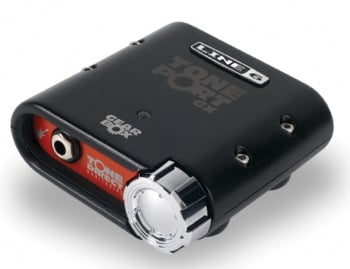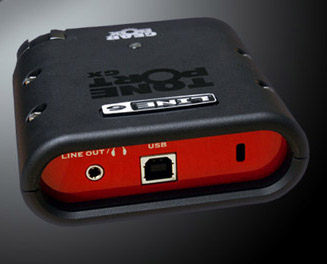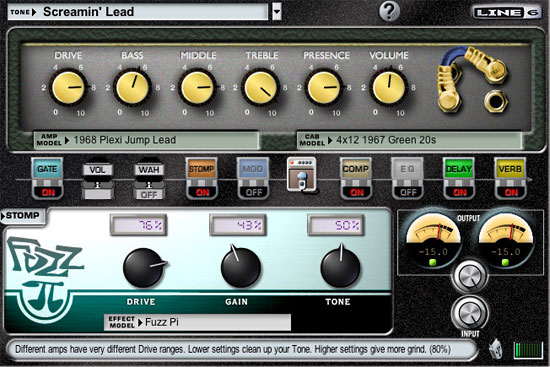Toneport gx
| Line 39: | Line 39: | ||
Toneport GX also features a master volume control wheel in the front, useful to tweak the overall output fast & easy after changing between clean and noisy presets. <br> | Toneport GX also features a master volume control wheel in the front, useful to tweak the overall output fast & easy after changing between clean and noisy presets. <br> | ||
| - | Not many connections, but this is the entry level of the Toneport family so that was expected. Enough for the casual guitar swinger though. Bigger, better models such as Toneport UX1 and Toneport UX2 offer extra input jacks for two instruments at a time and even XLR Mic preamp connections to record voicing. Be sure to check them out at their [http://line6.com/toneport/ Line6 Toneport Site]! And read Ivan Milenkoviv's great[https://www.guitarmasterclass.net/guitar_forum/index.php?showtopic=9152 review] about Toneport UX1 in our forums.<br> | + | Not many connections, but this is the entry level of the Toneport family so that was expected. Enough for the casual guitar swinger though. Bigger, better models such as Toneport UX1 and Toneport UX2 offer extra input jacks for two instruments at a time and even XLR Mic preamp connections to record voicing. Be sure to check them out at their [http://line6.com/toneport/ Line6 Toneport Site]! <br> |
| + | And read Ivan Milenkoviv's great [https://www.guitarmasterclass.net/guitar_forum/index.php?showtopic=9152 review] about Toneport UX1 in our forums.<br> | ||
Revision as of 14:18, 16 May 2008
Contents |
General Information
Weapon: USB Recording Interface
Make: Line-6
Model: Toneport GX
Price: Around 90$/80€
Sound
Toneports are recording devices made by Line 6 which are connected to our computers through USB. There are different models,one of them being the Toneport GX, which is the entry level to this great family of recording gadgets.
It can be used to record guitar, bass and even voice, through it's 1/4-inch input. No XLR inputs though.
The main advantage of using USB recording interfaces is that it avoids the latency issues that users experience when connecting their guitar to a conventional sound card. Using toneport users can record while listening to what they play in real time. This is possible thanks to it's built-in ASIO driver, which works pretty well.
Toneport GX can't be used as a standalone recording device, it needs to be connected to a computer to function, and it's power resides in a piece of software called Gearbox, which comes in the package and is also downloadable and updatable through line 6 downloads site.
It can be also used as a modeling & multieffect device to practice and jam along at home, connected to a nice set of speakers, monitors or even headphones for the ones who play at night or have complaining neighbors!. Surprisingly enough Toneport GX offers the functionality of some of the most advanced PODs when set up correctly. More about this later on ![]()
This thing is completely plug & play, which means once the drivers and software are installed you just plug it in and you are rocking. Take it with you in your gig-bag, and hook it to any laptop in the neighbourhood: you are set!
Connections
Let's take a look at its inputs/outputs:
- 1/4-inch input for instruments and microphone
- 1/8-inch stereo headphone/line output with master volume knob
- USB bus-powered with LED status indicator
Toneport GX also features a master volume control wheel in the front, useful to tweak the overall output fast & easy after changing between clean and noisy presets.
Not many connections, but this is the entry level of the Toneport family so that was expected. Enough for the casual guitar swinger though. Bigger, better models such as Toneport UX1 and Toneport UX2 offer extra input jacks for two instruments at a time and even XLR Mic preamp connections to record voicing. Be sure to check them out at their Line6 Toneport Site!
And read Ivan Milenkoviv's great review about Toneport UX1 in our forums.
Being Gearbox the soul of toneport devices, let's explain some of it's features:
- Amp/Cab modeling
- Effects & Stompboxes
- EQ
- Delay
- Reverb
- Noise Gate
- Presets
- Model Packs
- Customtone
All of this comes ready to tweak as if it was a real studio, where you can actually follow the chain of stomps, modulation gates, volume... and come up with almost any sound you can dream of. But as an image is worth a thousand words, take a glance:
One nice feature about Gearbox is it's built in Hum reducer, which can be switched on/off as needed. It has an option to actually "learn" the hum your axe is producing and then reduce it.
Installing Gearbox and it's drivers is easy. The program is updated regularly, as is expected now a days from reputable companies that care for their customers.
A closer look at the huge amount of power packed inside this tiny box reveals the following goodies:
Guitar Amp Models:
Line 6® Treadplate
Line 6® Chemical X
Line 6® Insane
Line 6® Piezacoustic 2
Line 6® Spinal Puppet
1953 Small Tweed based on Fender® Deluxe Reverb®
1958 Tweed B-Man based on* Fender® Bassman®
1964 Blackface 'Lux based on* Fender® Deluxe Reverb®
1967 Class A-30 Top Boost based on* Vox® AC-30
1968 Plexi Lead based on* Marshall® Super Lead
1968 Plexi Jump Lead based on* Marshall® Super Lead
1987 Jazz Clean based on* Roland® JC-120
1990 Brit J-800 based on* Marshall® JCM-800
1993 Solo 100 Head based on* Soldano SLO-100
2001 Treadplate based on* Mesa/Boogie® Dual Rectifier®
Tube Instrument Preamp
Citrus D-30 based on* Orange® AD30TC
Brit Gain 18 based on* Marshall® 1974X 18W Reissue
Bass Amp models:
Rock Classic based on* Ampeg® SVT
Flip Top based on* Ampeg® B-15A
Adam and Eve based on* Eden Traveler WT-300
Silverface Bass based on* 1967 Fender® Bassman® head
Eighties based on* Gallien Kruger 800RB
Effects
Facial Fuzz (based on* Fuzz Face)
Fuzz Pi (based on* Big Muff Pi®)
Screamer (based on* Tube Screamer®)
Classic Distortion (based on* ProCo Rat)
Vetta™ Comp Line 6® Sine Chorus
Line 6® Flanger Phaser (based on* MXR® Phase 90)
U-Vibe (based on* Uni-Vibe®) Opto Tremolo (based on* 1965 Fender® Deluxe Reverb®)
Rotary Drum & Horn (based on* Leslie® 145) Analog Delay Modulation (based on* Deluxe Memory Man)
Tube Echo (based on* EP-1 Tube Echoplex) Line 6® Digital Delay
Standard Spring Reverb Brite Room Reverb
Medium Hall Reverb Cavernous Reverb
Slap Plate Reverb Wah (based on* Vox® Wah)
Volume (Pre- or Post-Amp Routing options) Compressor (based on* LA-2A® Compressor)
Noise Gate Female De-Esser
Male De-Esser
Bass Overdrive (based on* Sans Amp bass Driver)
Bronze Master (based on* Maestro® Bass Brassmaster)
Sub Octaves (based on* L6 original synth effect)
Weeper (based on* Arbiter® Cry Baby)
On top of all that there are several cabs you can choose for each of the amps, making the amount of sounds virtually endless.
As if this wasn't enough, Toneport GX sports one of the most important features also present on his bigger counterparts: It CAN be upgraded thanks to Line 6 Model Packs, which are available at Line 6 site for an extra fee. Good news is that they can expand the power of our device to match a POD XT live. And beyond, if you get all the available packs. Now, how cool is that?
Last but not least, Toneport family of products allows users to trade their custom made tones through their dedicated site Customtone.
Gearbox comes already quite packed with tones that range from crystal clear to modern high gain, and everything from overdrives, crunch and alternative fuzzes in the middle. Not bad. As usual, rather than using these settings as they come, they provide an excellent base for the user to tweak and get their ultimate custom tone. Until the next recording session!
Feel
Quite easy to use thanks to Gearbox intuitive interface, basic and more complicated functions are straight forward to change, adjust and save. Feels like having a real amp and stomps all over the floor for you to tweak and crank. And that feels good!
One thing that may cause some troubles to some users on their first try is that Toneport is actually an external sound card, and as such needs to be assigned to the different programs to use. That means that whatever program you decide to use to record your tunes you will have to set Toneport as the desired sound card. Once that is understood everything is piece of cake.
Talking about this I guess it's important to clarify that Toneport + Gearbox alone are not enough to record. You will need an extra program such as Reaper or Audacity to actually record the different trackas and render them together into a song. No problem whatsoever, as some of these great recording programs are available through internet sometimes free of charge.
Cons
- Lack of XLR input (though you can use an adapter)
- It doesn't bake cookies or put butter on your toast
(Ok, ok.. I guess there certainly is not much to blame on this cute box, but that's good news isn't it?)
Overall Impression
Awesome gadget. Seriously. Like recording for dummies come true, this box allows recording your riffs fast and simple, yet boasts the power of a full-equipped studio at the command of your fingers.
Toneport + Gearbox is a great solution. All you need to choose is which model suits your needs best.
Alternative Weapon
If you are in the market for a recording device remember to check Toneport GX big brothers: UX1 and UX2. there's a rack toneport out there too, called UX8, for the pros out there.
Other alternatives could lead us to devices such as M-Audio Fast Track or Fast Track Pro. There's always a new gadget coming out almost each month, so do your homework before you decide.
Originally by Fran








